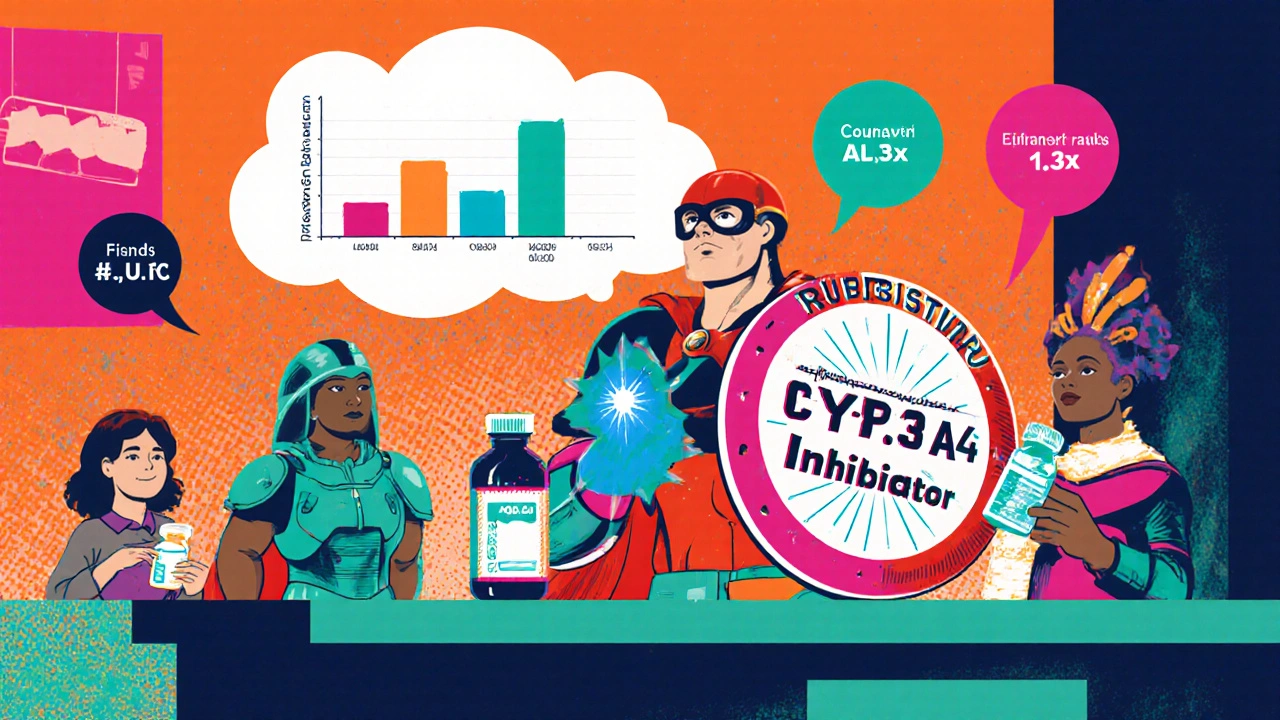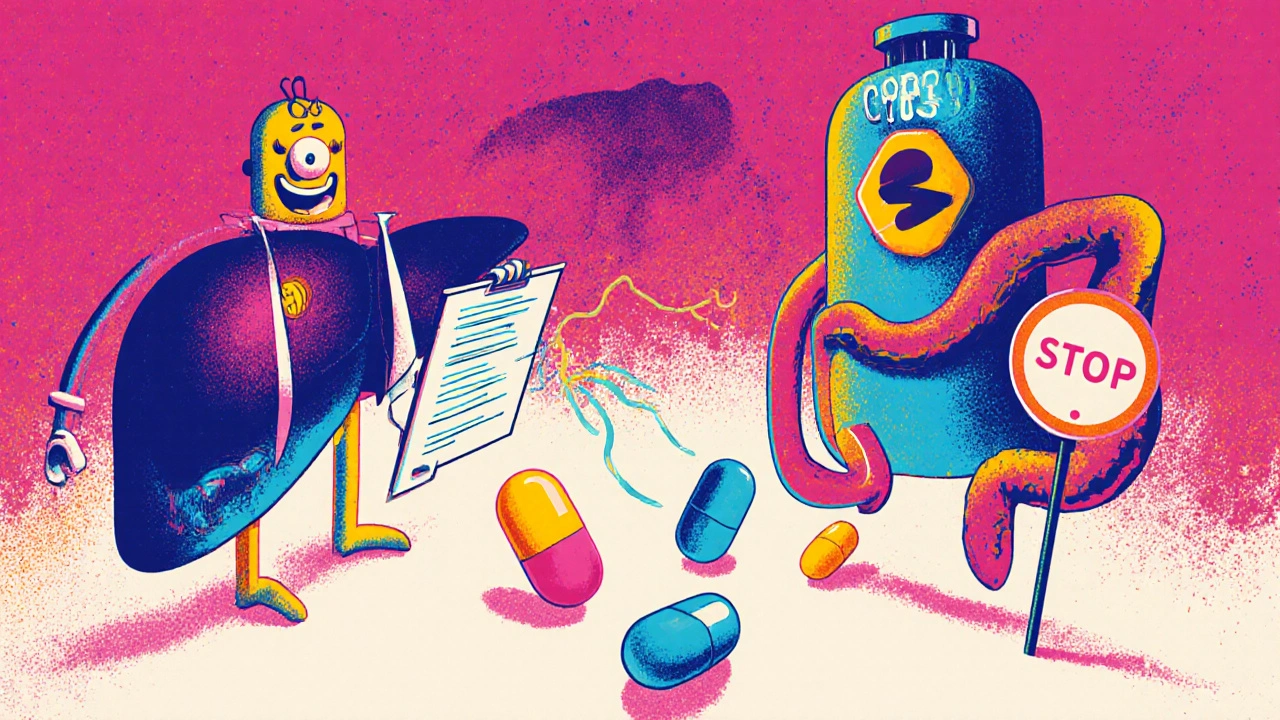Antiviral Drug Interaction Checker
Check interactions between antivirals and other medications using CYP3A4/P-gp pathways. This tool provides clinical interaction levels based on current guidelines.
When you start an antiviral regimen, the biggest hidden danger isn’t the virus - it’s how the drugs move through your body. Two proteins, CYP3A4 and a cytochrome P450 enzyme that metabolises roughly half of all prescription medicines, and P-glycoprotein (P‑gp), an ATP‑driven efflux pump encoded by the ABCB1 gene, are the gatekeepers that decide whether an antiviral stays in the bloodstream long enough to work.
Why CYP3A4 and P‑gp matter for antivirals
Both proteins sit in the liver and intestinal lining. CYP3A4 adds chemical groups to drugs, making them easier to clear, while P‑gp pushes molecules back into the gut lumen or into bile. When a medication blocks either protein, the other drugs sharing that pathway can sky‑rocket in concentration. In HIV and hepatitis C therapy, that effect can turn a life‑saving pill into a toxic bomb.
Key players in the interaction landscape
- Ritonavir - a protease inhibitor used at low doses (≈100 mg) purely to inhibit CYP3A4 and, to a lesser extent, intestinal P‑gp.
- Cobicistat - a newer booster that blocks CYP3A4 without the CYP1A2 induction seen with ritonavir.
- Darunavir - an HIV protease inhibitor that can be given with either booster.
- Glecaprevir / Pibrentasvir - a hepatitis C duo with modest CYP3A4 involvement but notable P‑gp substrate status.
- Paritaprevir / Ombitasvir / Dasabuvir - a four‑drug hepatitis C regimen that leans heavily on CYP3A4 and P‑gp.
- Sofosbuvir - a hepatitis C backbone with minimal CYP metabolism but high P‑gp efflux.
- OATP1B1 and OATP1B3 - liver transporters that can be blocked by some DAAs, raising statin levels dramatically.
How strong is the CYP3A4 inhibition?
| Booster | Daily Dose | AUC Ratio (midazolam) | Key Additional Effects |
|---|---|---|---|
| Ritonavir | 100 mg | 11.3 | CYP1A2 induction, P‑gp inhibition (Ki 3.2 µM) |
| Cobicistat | 150 mg | 5.1 | No CYP1A2 induction, strong UGT1A1 inhibition |
| Darunavir (unboosted) | 800 mg | 1.2 | Minimal CYP activity |
These numbers translate into real‑world outcomes: a patient on simvastatin plus ritonavir can see a 1,760 % rise in statin AUC, often pushing the drug into the contraindicated zone.

Clinical stories that illustrate the stakes
- A 68‑year‑old on apixaban experienced fatal GI bleeding after starting a darunavir/cobicistat regimen; anti‑Xa levels spiked to 384 ng/mL (therapeutic 50‑250 ng/mL).
- Conversely, a 2022 HIV‑Medicine cohort (n=347) reduced interaction‑related adverse events from 18.7 % to 5.2 % by using the Liverpool interaction checker app during the first month of therapy.
- Patients on St. John’s wort reported a 57 % drop in ritonavir exposure, leading to loss of viral suppression in 3 % of cases.
These anecdotes echo the numbers from big studies: the 2021 Lancet Infectious Diseases analysis linked 17.3 % of adverse drug events in co‑infected patients directly to missed CYP3A4/P‑gp checks.
Step‑by‑step: Managing antiviral‑CYP3A4/P‑gp interactions
- Gather a complete medication list, including OTCs, supplements, and herbal products.
- Identify CYP3A4 substrates (e.g., statins, calcium channel blockers, certain anxiolytics) and P‑gp substrates (e.g., digoxin, dabigatran).
- Run the list through a reputable interaction checker - the University of Liverpool app or the FDA’s drug‑interaction database are both free.
- Classify each flagged interaction:
- Level 1: No action needed.
- Level 2: Monitor; adjust timing if possible.
- Level 3: Dose reduction or alternative therapy.
- Level 4: Contra‑indicated - choose a different antiviral or substrate.
- Document the decision, communicate with the patient, and set a follow‑up lab check (e.g., liver enzymes, anticoagulant levels) within 2‑4 weeks.
In practice, the whole process takes about 30 minutes for a new HIV patient and 15 minutes for a hepatitis C case, according to the Liverpool group’s protocol.
Tools that make life easier
The free Liverpool HIV Drug Interactions app has been downloaded 1.2 million times (Oct 2023) and matches expert panels 98.7 % of the time. For hepatitis C, the HepDB portal offers a similar P‑gp‑focused matrix. Many hospitals now embed these checks into Epic or Cerner, generating automatic alerts that cut severe interactions by roughly 30 %.
Emerging trends and what’s on the horizon
Physiologically‑based pharmacokinetic (PBPK) models are getting good enough to predict the dual inhibition/induction profile of ritonavir with 94.7 % accuracy (2023 CTS study). Pharmacogenomics is also entering the clinic: patients with the CYP3A5*3/*3 genotype experience a 2.3‑fold increase in tacrolimus exposure when paired with ritonavir, prompting dose‑adjustment algorithms in transplant centers.
New antivirals like lenacapavir have been engineered to avoid CYP and transporter entanglements altogether, which could simplify therapy for the aging HIV population that now averages 4.7 comorbidities per person.
Quick reference cheat sheet
- Boosters: Ritonavir - strongest CYP3A4 inhibition, also induces CYP1A2; Cobicistat - moderate inhibition, no induction.
- High‑risk combos: Ritonavir + simvastatin, grazoprevir + cyclosporine, darunavir/cobicistat + apixaban.
- Low‑risk combos: Sofosbuvir‑based regimens with most comedications; glecaprevir/pibrentasvir requires only occasional P‑gp monitoring.
- Herb/food alerts: St. John’s wort ↓ ritonavir; grapefruit juice ↑ ritonavir; high‑dose calcium supplements may compete for P‑gp.
Frequently Asked Questions
Why does ritonavir boost other antivirals?
At 100 mg daily, ritonavir binds to the heme iron of CYP3A4, slashing its activity by up to 92 %. That slowdown lets co‑administered drugs that are CYP3A4 substrates stay in the blood longer, raising their exposure enough to achieve therapeutic levels without increasing the dose.
Can I take a statin with a ritonavir‑boosted regimen?
Only if you switch to a statin that isn’t heavily metabolised by CYP3A4, such as pravastatin or rosuvastatin, and you monitor lipid levels closely. Simvastatin and lovastatin are contraindicated because their AUC can jump by over 1,000 %.
Does cobicistat have any induction effects?
No. Cobicistat was designed to avoid the CYP1A2 induction that ritonavir shows. That makes it a cleaner booster for patients who need drugs metabolised by CYP1A2, but it still blocks CYP3A4 strongly.
How do I handle P‑gp substrates like digoxin?
Ritonavir’s Ki for intestinal P‑gp is 3.2 µM, which can raise digoxin levels about 2.8‑fold. The safest route is to either hold digoxin during the first two weeks of ritonavir therapy and re‑check serum levels or switch to a non‑P‑gp substrate such as amlodipine for rate control.
What role do OATP transporters play?
Drugs like grazoprevir are OATP1B1/1B3 substrates. Strong OATP inhibitors (e.g., cyclosporine) can cause AUC spikes up to 17‑fold, which is why those combos are listed as Level 4 contraindications in the 2023 EASL guidelines.
Understanding the dance between antivirals, CYP3A4, and P‑gp isn’t optional - it’s the difference between curing a virus and sending a patient to the ER. By using a systematic screen, the right tools, and staying aware of emerging data, clinicians can keep the therapy effective and the side‑effects at bay.

Buddy Bryan
October 24, 2025 AT 20:33
Listen up, the CYP3A4 and P‑gp axis isn’t just academic – it’s the throttle on every antiviral you prescribe. When you add a booster like ritonavir, you’re basically slamming the brakes on metabolism, so concentrations sky‑rocket. That’s why a statin that’s a CYP3A4 substrate can turn toxic in minutes – the AUC jumps by over a thousand percent. The same principle applies to P‑gp substrates such as digoxin, which can double or triple their levels. Bottom line: always run a full interaction check before you ever write that prescription, or you’ll be dealing with adverse events you could have avoided.
Aaron Kuan
October 31, 2025 AT 15:26
Colorful pills, hidden chaos.
Brett Witcher
November 7, 2025 AT 11:20
It is incumbent upon the diligent practitioner to recognize that the pharmacokinetic interplay between antiviral agents and the enzymatic and transporter systems, specifically CYP3A4 and P‑glycoprotein, constitutes a paradigm of clinical significance. The inhibition of CYP3A4 by low‑dose ritonavir is quantitatively manifested by an AUC ratio of approximately 11.3 for midazolam, a prototypical substrate, thereby extending the systemic exposure of co‑administered drugs. Concurrently, the modulation of intestinal P‑gp by the same booster augments the absorption of otherwise efflux‑limited compounds, an effect that is non‑trivial in therapeutic contexts. One must appreciate that the synergistic inhibition can precipitate supratherapeutic plasma concentrations, as exemplified by the 1,760 % rise in simvastatin AUC when combined with ritonavir, a phenomenon that borders on contraindication. The clinical ramifications extend beyond lipid‑lowering agents; anticoagulants such as apixaban and anti‑arrhythmics metabolized by CYP3A4 are similarly vulnerable to over‑exposure. Moreover, the literature documents fatal outcomes, such as the gastrointestinal hemorrhage observed in a septuagenarian following the initiation of a darunavir/cobicistat regimen while on apixaban. These anecdotal and epidemiologic data converge to underscore the imperative of systematic interaction screening. Modern resources, notably the University of Liverpool HIV Drug Interactions application, provide a repository of curated data with an accuracy approaching 99 %, thereby equipping the prescriber with actionable intelligence. In practice, allocating a mere thirty minutes to conduct a comprehensive review can avert iatrogenic toxicity and enhance therapeutic efficacy. Furthermore, emerging physiologically‑based pharmacokinetic models are now capable of predicting dual‑inhibition profiles with commendable precision, heralding a future where individualized dosing regimens may be algorithmically generated. Hence, the onus is upon clinicians to integrate these tools into routine workflow, lest the complexities of CYP3A4 and P‑gp interactions remain an elusive specter haunting patient safety.
Benjamin Sequeira benavente
November 14, 2025 AT 07:13
Great deep dive! For anyone feeling overwhelmed, remember the workflow: list meds, flag CYP3A4 and P‑gp substrates, run the Liverpool checker, then categorize the interaction level. That systematic approach cuts errors in half and keeps patients on track. Keep pushing the team to adopt this habit – it’s a game‑changer.
Shannon Stoneburgh
November 21, 2025 AT 03:06
The guide is solid, but many clinicians still forget to adjust statins. Simple reminder: avoid simvastatin with ritonavir.
Nathan Comstock
November 27, 2025 AT 23:00
Honestly, it’s baffling how anyone can overlook such a basic rule. The American healthcare system prides itself on cutting‑edge science, yet we keep making these elementary mistakes. It’s a disgrace that the same people who champion innovation can’t follow a straightforward interaction table.
Terell Moore
December 4, 2025 AT 18:53
Ah, the classic “let’s ignore the interaction checklist because we’re busy” syndrome. How original. If you enjoy living on the edge, by all means keep mixing ritonavir with high‑dose statins – what could possibly go wrong?
Olivia Harrison
December 11, 2025 AT 14:46
That’s a fair point, but let’s keep the tone constructive. The interaction tables are there to help, and most errors arise from rushed prescribing. If we all take a moment to double‑check, we can prevent many of these avoidable adverse events.
Deborah Galloway
December 18, 2025 AT 10:40
I appreciate the thoroughness of this post. It really helped me feel more confident when reviewing meds for my patients.
Charlie Stillwell
December 25, 2025 AT 06:33
👍👍👍 This is 💊‑level insight! The jargon is on point, and the emojis capture the urgency. Let’s keep the pharma‑tech talk rolling. 🚀💉